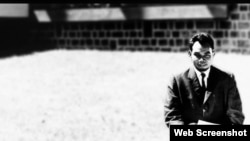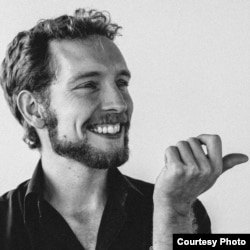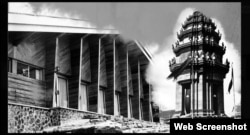[Editor’s Note: Featuring the life and work of Vann Molyvann, the legendary architect at the center of a renaissance in Cambodia’s Sangkum Reastr Niyum period, “The Man Who Built Cambodia” is a recently released narrative documentary directed by Christopher Rompre, a Canadian filmmaker based in Cambodia. As a co-founder and director at the Little Big Films, a video production company based in Phnom Penh, Rompre’s intention in producing the film was to help resurrect the neglected work of Molyvann. By giving Molyvann a platform to express himself, the film helps promote his message about having architects and city planners be attentive to how they approach design and architecture, having leaders be responsible for their actions, and having Cambodians – including the diaspora – be actively engaged in Cambodia’s development process. Rompre spoke to VOA Khmer reporter Sopheada Phy via Skype.]
VOA: Why did you decide to make the film?
CR: I first got interested in doing this documentary [when I was] spending time in Phnom Penh. I started noticing a lot of really interesting unique buildings faded in with a lot of other buildings around. There is the amazing national stadium that seems to be a home for all kinds of people to exercise or hang around in the evening. There is a very striking Independence Monument right in the heart of the city. There is a whole bunch of [unique buildings] like the Chaktomuk Theater; all these sorts of buildings. I started noticing that it’s sort of a unique style of modern architecture that I was so curious about. And then I started looking into who the architect was, who made all these buildings. It turned out that he [Vann Molyvann] had a really fascinating history, and he’s really done a lot of deep thinking about what the Khmer identity should be after colonialism, what a new Khmer architecture would look like. So I guess, it started off just having this really sort of innocent curiosity about where these buildings were coming from and who designed them. And it ended up sort of being this pathway into a much bigger story about Cambodia’s identity and where it stands today.
What is the documentary about?
When we first started working on this documentary, I really thought that we had been making a film about architecture, and I had the intention of really highlighting a lot of really fascinating ways that Vann Molyvann is a great architect. Before the term “Green Architecture” was thought in anyone’s mind, he was already designing buildings really creatively to integrate natural light and airflow, so that the buildings themselves operate almost completely without any external inputs or electricity. They are naturally cool, naturally lit. So the film started up by really focusing on Vann Molyvann’s architecture, and as we spoke with him more and more, it became clear that Vann Molyvann was really a deep thinker in terms of philosophy and cultural identity. I think a lot of his work really reflects something a lot richer than just an engineer’s architecture, that it actually reflects the deep thinking of a man who was really trying to wrestle with the next step for Khmer identity or something that draws from the really ancient tradition of Khmer Angkorian design and buildings, sort of fused with a lot of modern post-war ideas that were coming out from Europe and other architectural movements.
What are the most important takeaways you think the audience can learn from the film?
Well, it’s an interesting question. I think there are two audiences for this film. One, the international audience – people who are just really interested in architecture and this sort of exploration of cultural identity. I think a lot of people who have seen this film outside of Cambodia have really been fascinated by the ideological question, and about Cambodia’s rocky history. To me, when you start showing the film to Cambodians, that’s when it gets really exciting. You start seeing Vann Molyvann’s story and his ideas really trigger in Cambodian people, a real nostalgia for a time when creativity was running high and when there was a lot of optimism. And I think when you contrast that to the way that people feel about Cambodia today and where it is going, it’s sort of a natural comparison. For me, I’m most excited to be able to show it to Cambodians who are in Cambodia, and also to show the film to the diaspora populations.
What do you think about Molyvann’s feelings towards recent infrastructure development in Phnom Penh and about his own legacy?
This is certainly a question I get very often. I certainly don’t want to speak for Vann Molyvann. I think one thing we tried to do in the film was really let Vann Molyvann speak for himself. I don’t want to presume how he feels about infrastructure and this sort of development in Phnom Penh today other than that it’s very clear that he believes that architects and city planners, and even any public officials have a responsibility to the Cambodian people and to treat the responsibilities they have seriously, and to be thoughtful about the way they approach design and architecture.
What do you think Molyvann’s ideas for future planning in Phnom Penh are?
I think, essentially, Vann Molyvann doesn’t feel like he has the answer for how Phnom Penh should be developed today in terms of specific details about what should go where. I think what he is really advocating is for a younger generation of architects to take a run and to really reinvent their own version of new Khmer architecture, and to build on what came before, both from the Angkorian time and the new Khmer architectural era of the 1950s and 1960s. He’s a very humble man. He does not often talk about his own work as being somehow extraordinary.
Do you think his work or legacy has been neglected?
I think that’s been one of the most amazing parts of getting to be involved in this whole project of doing this film. It’s been really amazing making the film that has helped resurrect the work of Vann Molyvann and his thoughts and ideas in the minds of so many young Cambodians.
What are Molyvann’s hopes for the future of Cambodia?
Well, throughout the time that I spent speaking with him – a number of interviews over a year and a half – I do think that his recommendation for Cambodia and Cambodians is for people to get engaged, to see themselves as actors in the creation of a new Cambodia, and that message, to some people, is political. I think some [powerful] people are afraid of the power that people have when they get involved, when they stand up and say no to certain things. But for him, there can be no basis for a strong Cambodian nation that doesn’t start with Cambodian people being active or engaging with what their leaders are doing, and speaking freely about what they need. In terms of his recommendation, it would really just be to not let the important decisions be made without your voice being heard.
I think there are a lot of Cambodians, at least from the perspective of Vann Molyvann, who don’t want to get involved in politics or get involved in speaking out. I think he’s just basically urging people to understand that not speaking out, not engaging, or not participating has its own consequences, which maybe that the sort of future of Cambodia is not necessarily the one that you want to see. I think he says now it’s the time to engage, now it’s the time to participate in what it means to be Cambodian and what the future of the Cambodian state is, because it’s changing very rapidly, and those changes are going to have long term impact on the future of the country, not only in terms of architectural and design perspectives, but also in terms of the cultural and political characters of the country. What he’s saying is urging people to just engage, really engage.
Note: This interview has been edited for length and clarity.









